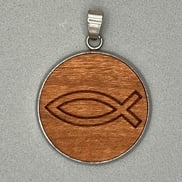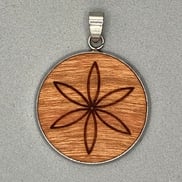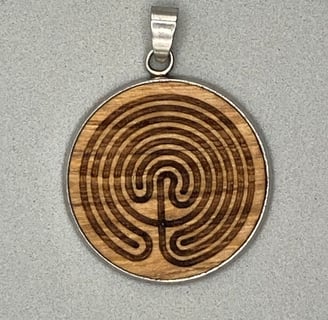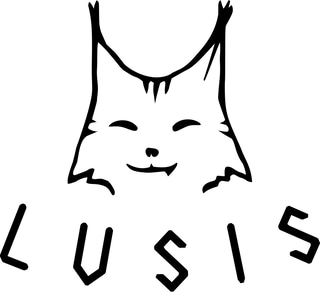Others


Ichthys
The Ichthys symbol, also known as the Christian fish symbol, is a simple but powerful emblem representing Christianity. The symbol consists of two intersecting arcs that form the shape of a fish. It derives from the Greek word ichthys (ἰχθύς), which means "fish" and is an acronym for the phrase Iēsous Christos, Theou Yios, Sōtēr (Ἰησοῦς Χριστὸς, Θεοῦ Υἱὸς, Σωτήρ), meaning "Jesus Christ, Son of God, Savior." In early Christianity, the Ichthys symbol was used as a secret sign among Christians during times of persecution in the Roman Empire. It was a discreet way for believers to identify one another without drawing attention. The fish also has significant biblical symbolism. In the New Testament, Jesus performed miracles involving fish, and he called his disciples "fishers of men," symbolizing their role in spreading the gospel. Today, the Ichthys is widely recognized as a symbol of Christian faith and is often displayed on jewelry, car decals, and church decorations. It represents the belief in Jesus as the Savior and reflects key Christian teachings of salvation, discipleship, and divine protection.


Moon
The moon crescent is a powerful and ancient symbol that holds varied meanings across cultures and religions. Often associated with femininity, cycles, and change due to the moon’s phases, the crescent is especially tied to spiritual and temporal rhythms.In Islamic culture, the crescent moon (often paired with a star) is a prominent symbol representing faith and divine guidance. Though not originating from early Islamic teachings, it was adopted by the Ottoman Empire and later became associated with Islam globally. It is used today on many national flags of Muslim-majority countries.In ancient Mesopotamia, the crescent moon represented the moon god Sin (or Nanna), who governed time and wisdom. Similarly, in Greek and Roman mythology, the crescent is associated with the moon goddesses Artemis and Diana, symbols of purity, the hunt, and protection.In Hinduism, the crescent moon adorns the head of Lord Shiva, symbolizing the cycle of time and his dominion over it. It also reflects the idea of balance between destruction and renewal, as the moon wanes and waxes.In Pagan and Wiccan traditions, the crescent moon is sacred, representing the Goddess or feminine divine. It is part of the triple moon symbol: waxing crescent (maiden), full moon (mother), and waning crescent (crone), embodying the stages of womanhood and life's natural cycles.Across these traditions, the crescent moon generally conveys transformation, protection, divine presence, and femininity. Despite its varied interpretations, the recurring themes of change, spirituality, and the cosmos give the crescent a unifying symbolic power across cultures.


Ouroboros
The Ouroboros is an ancient symbol depicting a serpent or dragon eating its own tail. This powerful image represents the concept of cyclicality, unity, and the eternal cycle of life, death, and rebirth. The word Ouroboros is derived from the Greek words oura (tail) and boros (devouring), directly translating to "tail-eater." Historically, the Ouroboros has appeared in many cultures, including ancient Egypt, Greece, and Norse mythology. In Egyptian culture, it symbolized the cycle of the sun and the concept of eternal renewal, while in Greek philosophy, it was seen as a symbol of the unity of opposites and the self-sustaining nature of the universe. The Ouroboros is often interpreted as a representation of the infinite, unending process of creation and destruction. It suggests that all things are interconnected, and that life and death are not separate, but part of a continuous loop. In alchemy, it was used to represent the eternal process of transformation and the philosopher's stone. The Ouroboros is a symbol of wholeness, balance, and the perpetual renewal of life.


Germ of Life
The Germ of Life is a powerful symbol representing the origin or seed of existence, potential, and creation. Often used metaphorically, it refers to the smallest unit or beginning from which life or significant growth can emerge. In biological terms, a germ is the initial cell or organism that eventually develops into a complex life form. Symbolically, it embodies the idea of latent potential—the spark that contains within it the blueprint for full realization. Across cultures and philosophies, the Germ of Life is associated with birth, rebirth, and the cyclical nature of existence. In spiritual or mystical contexts, it may signify divine creation or the soul's journey from its pure origin toward fulfillment. Artists and writers often use the term to explore themes of inspiration, transformation, and the mysterious force that animates living beings. The symbol encourages a reverence for beginnings—however small—and a recognition that great things often arise from seemingly insignificant origins. It also carries hope, implying that even in darkness or dormancy, life and growth are possible, waiting for the right conditions to flourish.


Troy Town
There are many archaeological sites, especially in Scandinavia where this design serfs as a layout for landscape architecture. It consists of a continuous, interlocking series of spirals or squares, creating a labyrinth-like pattern. Various hypotheses exist about its meaning and origin. The oldest ones date at least back to the Bronze Age.
